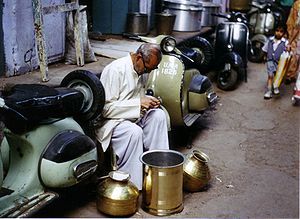Development from the past until today
Historically, craftsmen tended to concentrate in urban centers and formed the guilds. Trade occupation and the need to be permanently involved in the exchange of goods also demanded a generally higher level of education and in societal hierarchy the craftsmen were usually in a more privileged position than the peasantry.
The households of the members of the society occupied in trade professions were not as self-sufficient as of those engaged in agricultural work and, as such, had to rely on exchange of goods.
Once an apprentice of a craft had finished his apprenticeship, he would become a journeyman searching for a place to set up his own shop and make a living. After he set up his own shop he could then be called a master of his trade.
This system of a stepwise approach to mastery of a craft which invokes the obtainment of a certain amount of education and the learning of skills, has survived in some countries of the world until today, although craft has undergone deep structural changes during the era of the Industrial Revolution in which mass production of goods of the industry has limited craft to areas of life which the industry could not satisfy - due to its modes of functioning - or in which mass-produced goods would not meet the preferences of potential buyers. Moreover, as an outcome of these changes, craftspeople increasingly make use of semi-finished components or materials today, and accomplish and adapt such a kind of ware to their customers' demands and, if necessary, to the environments of their customers, taking it in hand, in case fitting-work is needed, and thus augment what the industry already had produced - through participating in a certain division of labour between industry and craft.
Handicraft: The "traditional" main sector of craft

The Arts and Crafts Movement

The term crafts is often used to describe the family of artistic practices within the family decorative arts that traditionally are defined by their relationship to functional or utilitarian products (such as sculptural forms in the vessel tradition) or by their use of such natural media as wood, clay, glass, textiles, and metal.
Studio crafts
Crafts practiced by independent artists working alone or in small groups are often referred to as studio craft.
Studio craft includes studio pottery, metal work, weaving, wood turning and other forms of wood working, glass blowing, and glass art.
Craft fairs
A craft fair is an organized event to display crafts by a number of exhibitors. There are craft shops where such goods are sold and craft communities, such as Craftster, where expertise is shared.
Craft as a classification
In English, to describe something as a craft is to describe it as lying somewhere between an art (which relies on talent) and a science (which relies on knowledge). In this sense, the English word craft is roughly equivalent to the ancient Greek term techne.
Folk art follows craft traditions, in contrast to fine art or "high art".
this article from : http://en.wikipedia.org/

No comments:
Post a Comment